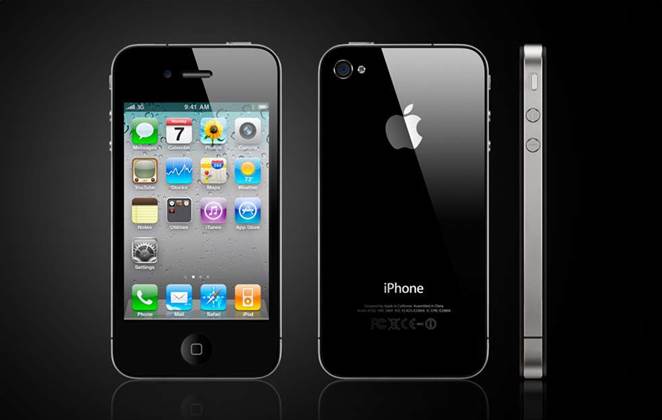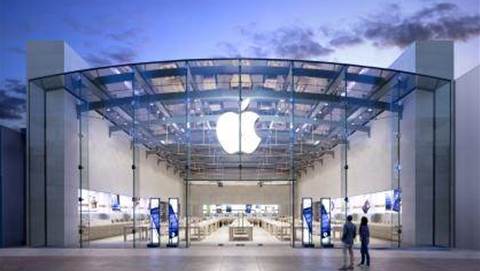The iPhone is here, and it’s not too expensive.

Let’s get that one out in the open right away. The 16GB version is $859: compare that to the HTC Desire at around $600. The key question is: is it worth more than a Desire? Even more importantly, is it worth that additional cost of ownership over a 24-month contract? And what of the controversy surrounding the antenna design and reception issue?
It’s certainly a design departure from iPhones past. The main difference with the new phone is that it’s both thinner (9.3mm vs 12.3mm) and a little narrower than the 3GS. The rear of the phone is flat, instead of shaped, and there are more sharp edges than curves. Some may take issue with this, arguing that it’s less comfortable to hold and more difficult to slide into a pocket than previous generations.
What you cannot argue with is that the new iPhone feels altogether more solidly made. The front panel is made from a tougher glass, which also now features on the rear panel, while the stainless-steel band that wraps around the edges of the device lends a classier look to this iPhone.
The oleophobic, fingerprint-resistant coating is also on the rear and the front, the upshot being that it’s easier to keep clean than the previous model.
The detailing is a little cuter too, with small round buttons instead of a rocker for the volume, exposed stainless-steel screws flanking the docking port at the bottom edge, and a pair of beautifully crafted ports for the stereo speakers next to each of these.
Screen star
The really big change, however, is what Apple calls its “Retina” display. There’s nothing technologically innovative about it and it’s no bigger than before either, measuring 3.5in across. It is, however, the highest-resolution smartphone screen on the market today. At 936 x 640, it crams in four times as many pixels as the previous iPhone.
And quality is top too. It uses the same IPS technology as the iPad, so colours are deep and rich, and viewing angles are wide. Sat side by side with a Desire it’s immediately noticeable that the screen isn’t as colourful or iris-dilatingly bright as that phone’s OLED screen. But what’s also obvious is that the Retina display is crisper, making small characters far more readable.
If you don’t mind the small screen area, it’s fine for reading iBooks on, and although not transflective, it’s perfectly readable in sunshine – a big bonus.
Software
The main headline on the software front is iOS4, and although this isn’t specific to the iPhone 4 (it’s a free update for 3GS and iPad owners too), it’s worth mentioning, because for the very first time it brings multitasking to the iPhone. Applications allow you to pick up where you left off, and some are able to run in the background while you get on with other things. (3G owners get the update too, but not the multitasking features.)
Double-tapping the home button brings up a list of recently used apps at the bottom of the screen, plus play, pause and track skip controls if you’re listening to music, and dismissing apps is simple. However, there are a couple of small caveats: developers need to recode and issue updates for the feature to work, so not every app will support it straight away; and it also means that, at least for apps that access the GPS chip, you need to keep on top of what’s running in the background, or you could find yourself running out of juice.
iOS4 also brings support for folders, allowing you to organise your apps into easily browsable sets, but the only thing that sets the iPhone 4 apart, in terms of software at least, is FaceTime – the iPhone’s new video phone application. This uses the phone’s front-mounted VGA camera to offer calls over Wi-Fi: all you do is make a standard voice call to another iPhone 4 owner, and as soon as they accept the FaceTime call, the voice call is dropped and the call continues seamlessly in video mode. The benefit is the video call is free, but you’re limited, at least initially, to calling other iPhone 4 users.
Interestingly, Apple has intimated that, since it’s built on widely used standards, third-party developers will eventually be able to hook into the system, raising the possibility of free iPhone 4 to PC-based video calls somewhere down the line. For now, though, it’s an interesting void.
Performance
The iPhone 4 now boasts the same A4 processor as the iPad. Not that it needed any improvement; the 3GS was already one of the quickest, most responsive handsets around – and the iPhone 4 is just as quick off the mark. In our tests, it loaded the BBC homepage (which is nicely complex for rendering time tests) in an average of nine seconds over a quick Wi-Fi connection, it’s very quick at launching apps, and it scored a perfect 100 in the Acid3 standards test.
The battery upgrade is more significant. As long as you keep on top of apps that use the phone’s GPS chip in the background – making sure you stop them running when you don’t need them – you’ll get a touch more life from the iPhone 4 than from the 3GS. After our tough 24-hour, real-world test, the iPhone 4 still had 60% remaining (rounded to the nearest 10%). That’s one notch up from its predecessor, an impressive achievement given all the extra pixels it has to power. There’s also now 802.11n Wi-Fi support and a three-axis gyroscope for more accurate movement sensing.
But it’s the camera that really impresses. Upped from three megapixels to five, and including touchscreen focus too, it produces crisp, colourful and remarkably detailed shots. It still won’t replace a proper compact camera, but as smartphone cameras go, this is one of the best. In another first for Apple, it also has a small, single LED flash.
There’s even an HD video camera mode that records footage in 720p – an impressive feat in its own right in a smartphone this slim. Alas, quality is not as good as with stills. Shakes of the hand introduce an annoying blurring and wobbling to footage, which also tends to look washed out.
It’s no substitute for a Flip mino HD or Creative Vado HD, but download the iMovie app for $4.99 and it really comes into its own, allowing you to trim and splice clips and photos together to create surprisingly good-looking results.
The signal drop problem
Finally, an iPhone 4 review wouldn’t be complete without addressing the well-publicised signal drop problem. As many users have reported, gripping the phone in a certain way causes the strength of signal to fall markedly. We have managed to replicate the problem, but to do so we had to grip it so hard, and in such an awkward manner, that it wasn’t a problem for us. Apple claims that it affects a small proportion of iPhone 4 users, and in a surprising press conference, announced it will provide free cases to allow users to avoid the problem.
We did notice after prolonged use that the top-right rear of the phone became uncomfortably warm. There was also a slight dullness in the top right corner of the screen at mid-brightness. We haven’t seen this on other iPhone 4s, so we’re hoping it’s a one-off.
We wouldn’t say that any of these issues were big enough to prevent us recommending the iPhone 4. It offers the best combination of design, performance and software on the smartphone market right now, and it backs this up with the best selection of apps on any smartphone platform too.




















